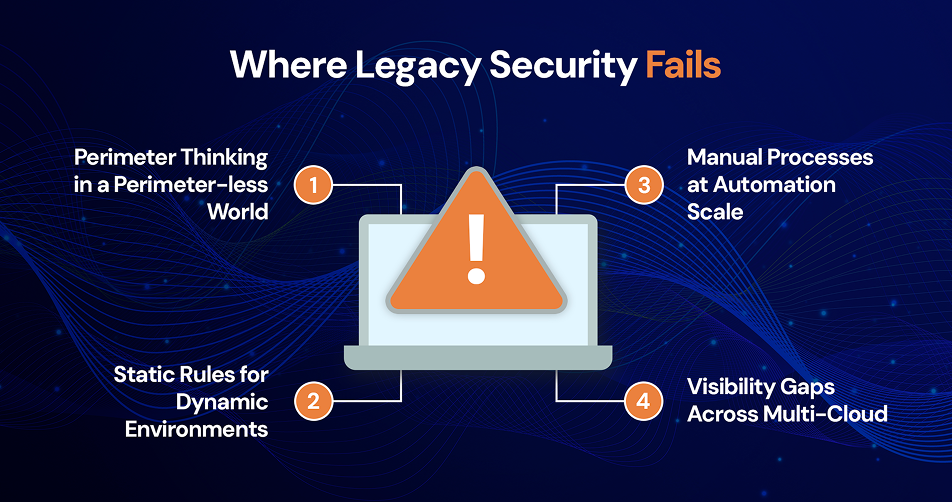Table of Contents
The cloud has fundamentally changed how businesses operate, enabling agility, scalability, and innovation at unprecedented speed. But there's a disconnect that many organizations are only now confronting: their security strategies haven't evolved at the same pace as their cloud infrastructure.
Traditional security was designed for fortress-like on-premises environments. It struggles in today's cloud ecosystems where resources spin up in minutes, data flows across regions in seconds, and threats move at machine speed. While Cybersecurity Awareness Month (October) has concluded, it is crucial to address a critical question: Is your cloud security strategy built for the threats of 2025, or is it fighting yesterday's battles?
To stay ahead, security must operate at what we at DBiz.ai call Cloud Velocity.
The Speed Gap: Where Breaches Begin
Consider the terrifying timeline of a modern cloud security incident. A threat actor discovers a single misconfigured storage container. Within seconds, automated tools scan and exfiltrate sensitive data. Minutes later, that data appears on dark web marketplaces, turning a minor error into a compliance nightmare. The entire incident, from initial access to data loss, can unfold in under an hour.
Now, contrast that with the typical enterprise security response. Alert generation might be quick, but investigation involves time-consuming steps like validating the alert, determining scope, assessing impact, coordinating response, and implementing remediation. Even well-staffed Security Operations Centers often measure this manual process in hours or days.
This vast Speed Gap is precisely where breaches happen. Your response is measured in hours; the attack is measured in seconds.
The "555" Standard: Defining Cloud Velocity
Forward-thinking security teams understand that human-paced security simply can't compete with automated threats. At DBiz.ai, we guide our clients toward a new, quantifiable benchmark for detection and response: the "555 Cloud Detection and Response" Standard:
- 5 seconds to detect a security event.
- 5 minutes to investigate and understand the threat.
- 5 minutes to respond and contain the incident.
Achieving this benchmark requires fundamentally rethinking cloud security architecture, replacing manual processes with the kind of intelligent automation we embed in our Microsoft Azure implementations.
Where Legacy Security Fails
Legacy security models create several critical gaps in cloud environments:
- Perimeter Thinking in a Perimeter-less World: Cloud applications connect to multiple services, regions, and users from anywhere. The single wall approach is obsolete.
- Static Rules for Dynamic Environments: Cloud resources appear and disappear in minutes. Static firewall rules and security groups cannot possibly keep pace with this dynamism.
- Manual Processes at Automation Scale: When security teams manually review alerts, they are overwhelmed. This is why DBiz.ai prioritizes Security Orchestration, Automation, and Response (SOAR) capabilities, leveraging tools like Azure Sentinel for scale.
- Visibility Gaps Across Multi-Cloud: Most organizations use multiple platforms. Traditional tools lack the unified view necessary to eliminate blind spots, which is a primary focus area in modern DBiz.ai deployments.

The Real-Time Security Toolkit
Effective cloud security requires embracing automation, intelligence, and speed. Our architecture approach focuses on three core pillars:
- The Real-Time Security Engine
We move past periodic reviews by implementing Continuous Security Posture Management (CSPM). Automated tools assess every resource against security benchmarks, flagging deviations immediately. Crucially, we also integrate security policies directly into Infrastructure-as-Code (IaC), ensuring that risky deployments are prevented before they ever hit the production environment. - Identity: The New Perimeter
In the cloud, identity is the new control plane. This reality demands an identity-centric security model:- Zero Trust Architecture: Assume nothing is trusted by default. Every access request must be authenticated and authorized. DBiz.ai designs Zero Trust based on the robust identity features in Microsoft Azure, extending it to all connected services. [https://csrc.nist.gov/pubs/sp/800/207/final]
- Least Privilege Access: Grant only the minimum permissions necessary. We specialize in mapping least-privilege roles to organizational structure, significantly reducing the impact of compromised credentials.
- Privileged Access Management (PAM): We implement strict controls around administrative accounts, including Just-in-Time access elevation and session monitoring, turning high-value targets into tightly controlled assets.
- DevSecOps Integration
Security cannot be a separate function. DBiz.ai embeds security into the CI/CD pipeline. This means automated security testing, vulnerability scanning, and compliance checks run with every code commit. Problems are caught and fixed during development, achieving true prevention rather than belated detection, allowing your teams to innovate faster, without fear.
Taking Action: Close the Gap with Confidence
The cloud offers tremendous business value, but only when organizations can move fast with confidence. That confidence comes from security architectures designed for cloud reality, which translates to automated, intelligent, and operating at the velocity and dynamism of the modern cloud.
- Can you detect threats in seconds? Investigate in minutes? Respond before damage scales? If not, identify the gaps preventing you from reaching the "555 Standard."
- Does your architecture rely on perimeter-based thinking, or is it built for Zero Trust reality?
DBiz.ai designs and implements cloud-first architectures on Microsoft Azure with security embedded at every layer. Our approach ensures you meet the '555' benchmark, combining DevSecOps practices, automated security controls, and continuous monitoring to enable your teams to innovate rapidly while maintaining a robust security posture. Ready to see how fast your security can operate? Contact us today to start your cloud security maturity assessment.


